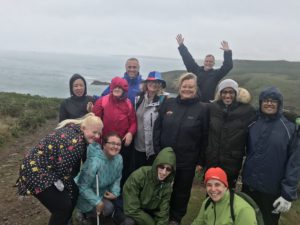The volcanic island of Skomer, a National Nature Reserve off the coast of Pembrokeshire in west Wales, was chosen as the location for delivering VICTA’s first John Muir Discovery Award. Working with the Wildlife Trust of South and West Wales, we introduced seven young adults (18 to 29 years) to some of the conservation ideals and research programmes on the island. While the remote location and five night residential in self-catering accommodation without mains electricity, gas, water and limited mobile reception and poor Wi-Fi, satisfied ‘the back to nature’ element of the award.

The island is famed for its wildlife and is home to the largest Atlantic puffin colony in southern Britain. However, our visit was timed to witness the feeding patterns of around half the world’s population of Manx shearwaters (250,000 pairs) that return to feed their chicks. Returning to their burrows (not nests) under cover of darkness, to avoid gull strikes, their calls fill the night sky while their clumsy landings mean everything and everyone is a potential target.
The experience was hands-on, as the island’s wardens allowed us to engage in a number of their research projects including:
- a six-hour cetacean watch
- a butterfly transect
- attending the ‘bird log’ – a daily 9pm meeting at which all island staff & volunteers share findings for recording in the island log
bracken spreading / drying for use on the compost toilets - beachcombing exercise to help develop a template for working with VI students
- decommissioning a bird hide
- handling manx shearwater chicks as part of a talk on the necessity for weighting, tracking and counting the birds
- handling local reptiles including slow worms and toads as part of a talk on how the slow-worm is neither a worm nor a snake, but a legless lizard – its identity is given away by its abilities to shed its tail and blink with its eyelids
- We also debated the importance of National Parks (as imagined by John Muir) against the growing movement in the US calling for such parks to be urbanised resulting in unanimous support for John Muir’s vision.
- The five days provided enough time to explore and develop a solid understanding of the island’s geography and wild terrain which was achieved through a number of walks incorporating the coastal perimeter and inland meadows.
- Walks were timed to witness dawn and sunset, low and high tides, to maximise wildlife spotting and experience different wildlife behaviours. All walks and activities were curated to maximise light, shadow, colour, sound, smell and touch.
The coastal walks in addition identifying the calls of, and spotting wildlife such as whales, dolphins and seals also provided opportunity to develop an understanding of the island’s history as the remains of many Iron Age walls and settlements were explored. Much of the island has also been designated a Scheduled Ancient Monument by Cadw, the Welsh Government Heritage Agency. The main settlement of the island can be dated to between 5000 and 2000BP, and evidence and remains from this period can be seen all around the island. The remains of huts, fields and cairns (possibly burial cairns) on Skomer are some of the most complete and untouched remains of this period in the whole of Europe, and their extent indicates an Iron Age farming community of up to 200 people.
Beyond the demands of the conservation volunteering, our young people had to navigate unknown and difficult terrain which pushed most (including volunteers) beyond their suburban comfort zones. It required communication, and trust to support each other and work as a team to be able to navigate the island safely. As young VI people attuned to using technology to aid their daily lives, an island environment provided opportunities for them to strengthen key life skills such as problem solving, way finding, resourcefulness, responsibility and interpersonal skills including discussion, collaboration, respect, dependability, commitment, resilience, listening and positivity.
Sharing activities included cooking together, recalling observations and ‘deciding who does what’ which further strengthened emotional intelligence, built confidence between individuals and created positive and meaningful relationships.
[ngg src=”galleries” ids=”38″ display=”basic_thumbnail”]











Leave A Comment